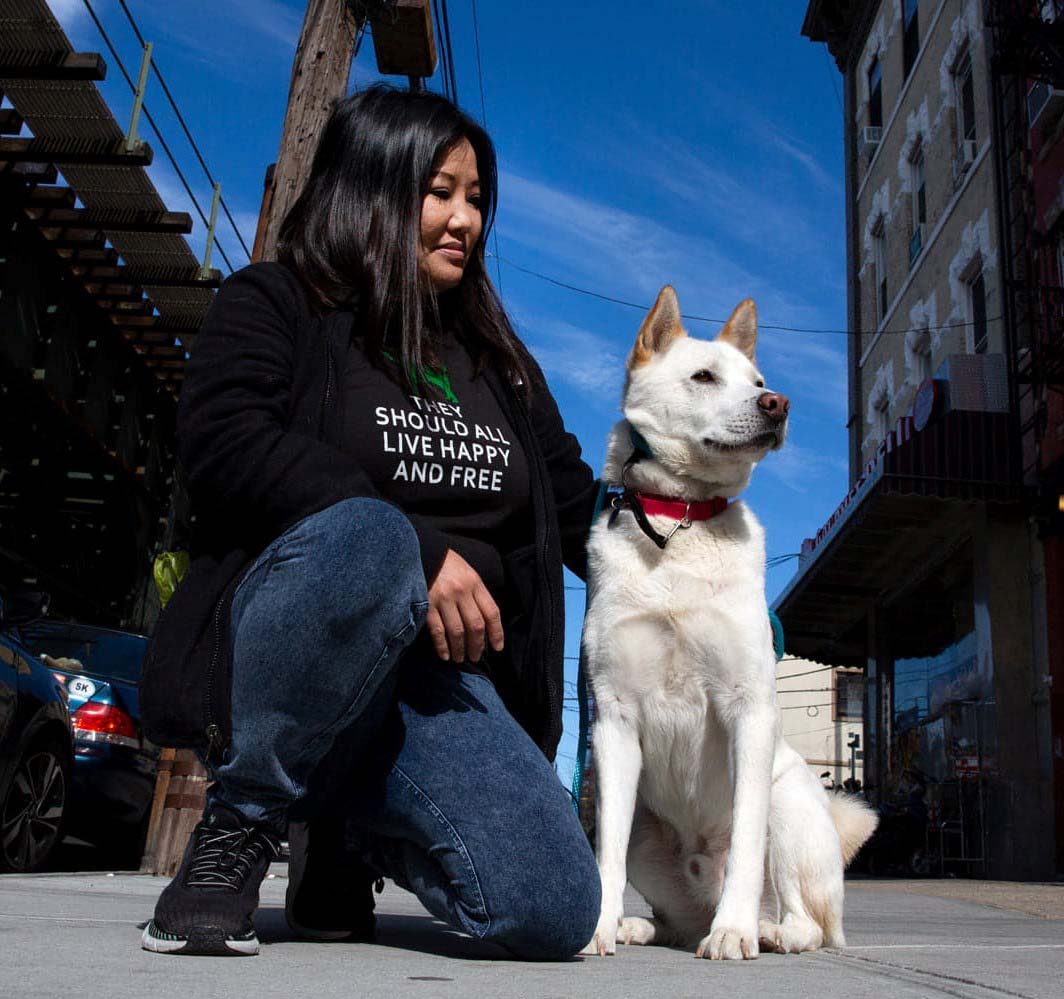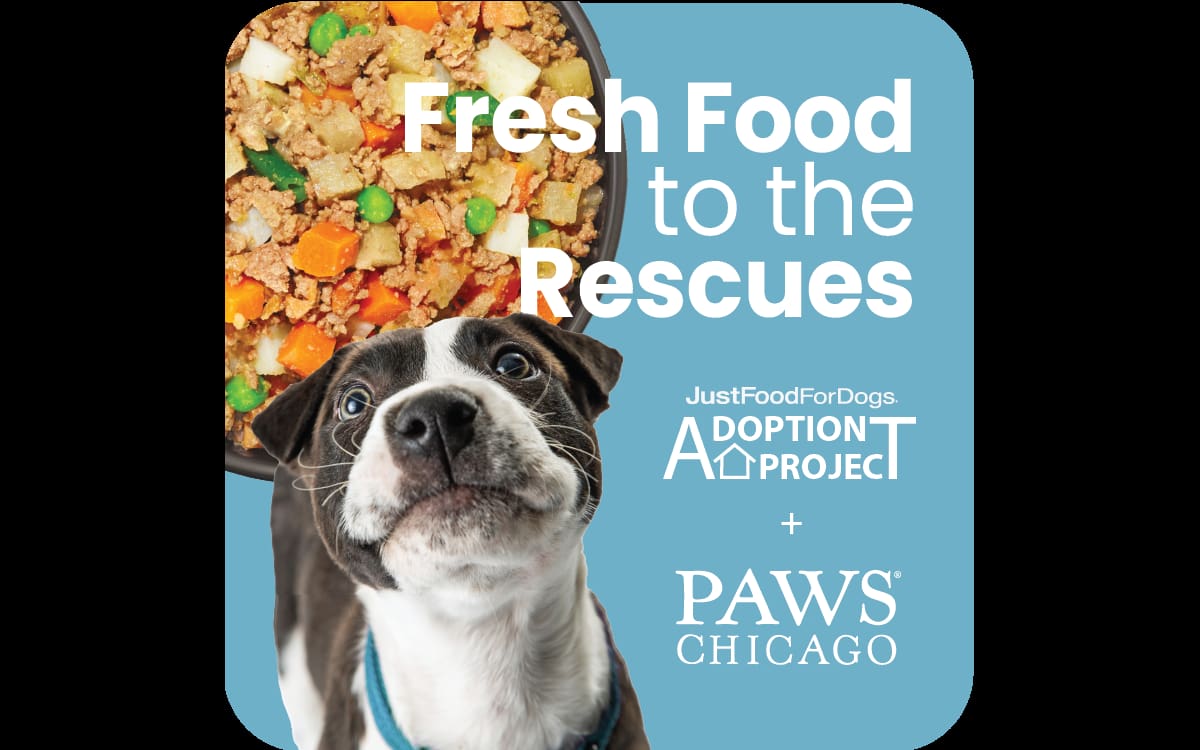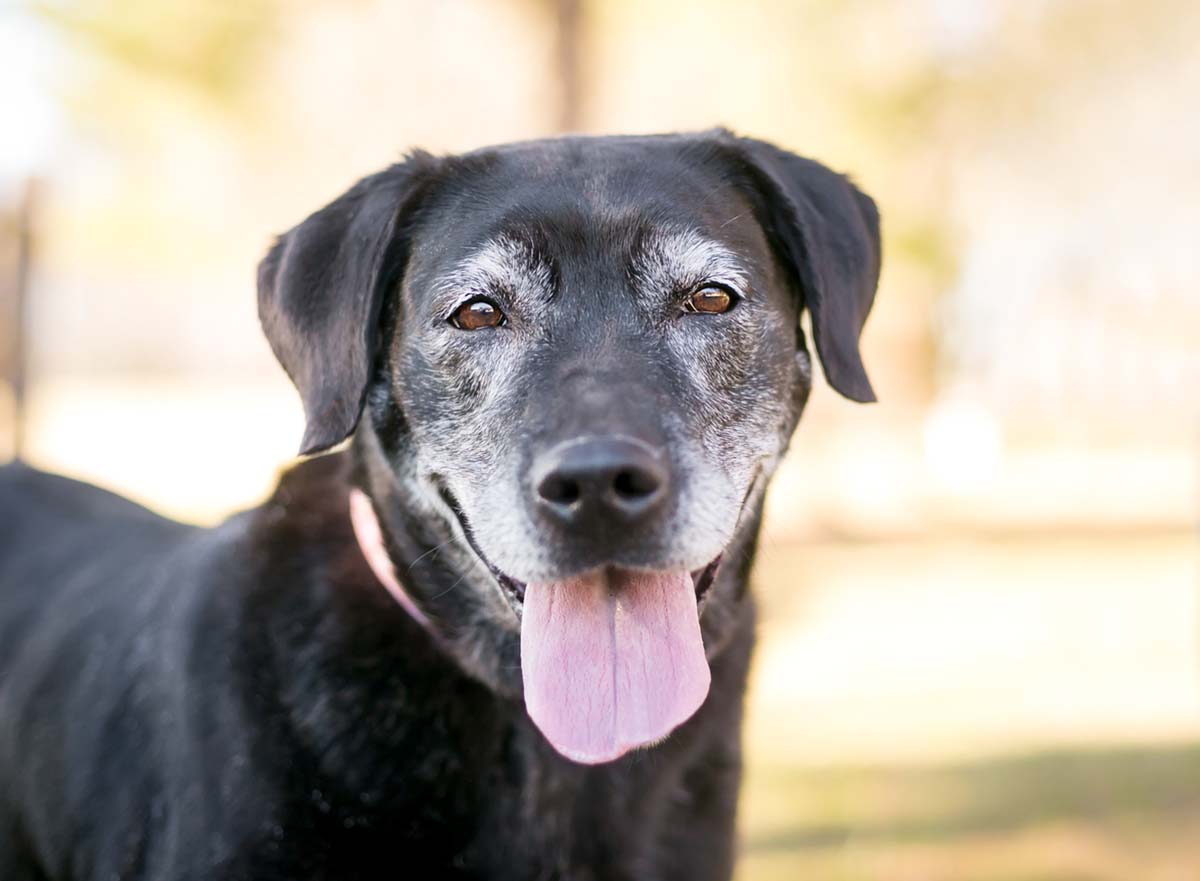AP Rescue Partner Spotlight: Korean K9
Every day, individuals at Korean K9 Rescue work tirelessly to rescue dogs from the abhorrent dog meat trade and puppy mills of South Korea.
By Natalie Lykins
If you have ever wanted to meet real-life superheroes, all you have to do is visit a little neighborhood in Queens, New York. There you will find the team from Korean K9 Rescue, led by Gina Boehler. Every day, they work tirelessly to rescue dogs from the abhorrent dog meat trade and puppy mills of South Korea. As dogs arrive in New York, after their long journey, Gina and the team are there to meet them with cozy beds and nutritious meals. I spoke with Gina about this process, the state of animal welfare in South Korea, and the bravery of these very special dogs.
You have been involved in animal rescue and rehab for years. What led to the official founding of Korean K9 rescue?
When we started in 2017, I had been to South Korea to visit family. I was pretty active in my local rescue scene, helping out where I could, volunteering and driving transport from the southern states to northern states. When I went to Korea in 2016, I was interested to see what a Korean shelter looked like, so I went to visit a shelter that was right on the border of North Korea. When I went there, I thought “Oh my God, this is crazy! This is nothing like the shelter in the United States!”
There were so many dogs, and they were so traumatized, and they all come from neglected, cruel backgrounds, so it was just a whole different vibe. They were living outdoors in pens and there was no real ratio of volunteers and help to the number of dogs that shelter had. Then the shelter manager said to me “There is a dog meat farm down the road if you want to go see it”. I started walking down the road about a quarter of a mile and literally the road led right up to a dog meat farm. You could hear the dogs barking from behind the trees. There were about 200 dogs there and they were in the process of being rescued, but the thing about dog meat farms is that you can’t just go in and extract the dogs.
Number one, it’s a lot of dogs. Two, they are living in such neglected conditions with feces in the cage piled so high that they are literally walking and pacing around their feces. It’s a very daunting task. It looked like something out of a movie. Like, it can’t be real, but it’s real. There were even dogs tied up outside, like cocker spaniels and other purebreds, chained outside and I just wanted to be able to do something. These people that were sacrificing their lives to be a shelter for these dogs had no outlet for these dogs to go to. There was no adoption scene in Korea. It didn’t exist like it does today. If it did exist, it was less than 10% of people who were adopting these dogs locally. There was no outlet for big dogs, or even what we would consider medium and small-sized dogs to be adopted in Korea.
A lot has changed since then. The adoption rate has increased a bit more, but that’s how I got started. I decided to bring over three dogs at a time, then it became four, then it became six, and now we bring over an average of 30 to 35 dogs a month to New York. We are working on LA, to get more dogs out there. That’s how we started.
I really didn’t know how people would react to having the dogs here. I just took a chance and thought New York is a very diverse place, it’s very open and very accepting. Same thing with Los Angeles. The response was overwhelming. They loved Korean dogs, they loved our mission, they loved what we were doing. Ever since then, there has been an increased acceptance. I just thank everybody for supporting our mission. There are a lot of rescue groups around doing wonderful things, but ours is solely focused on South Korea, and giving those dogs a chance.
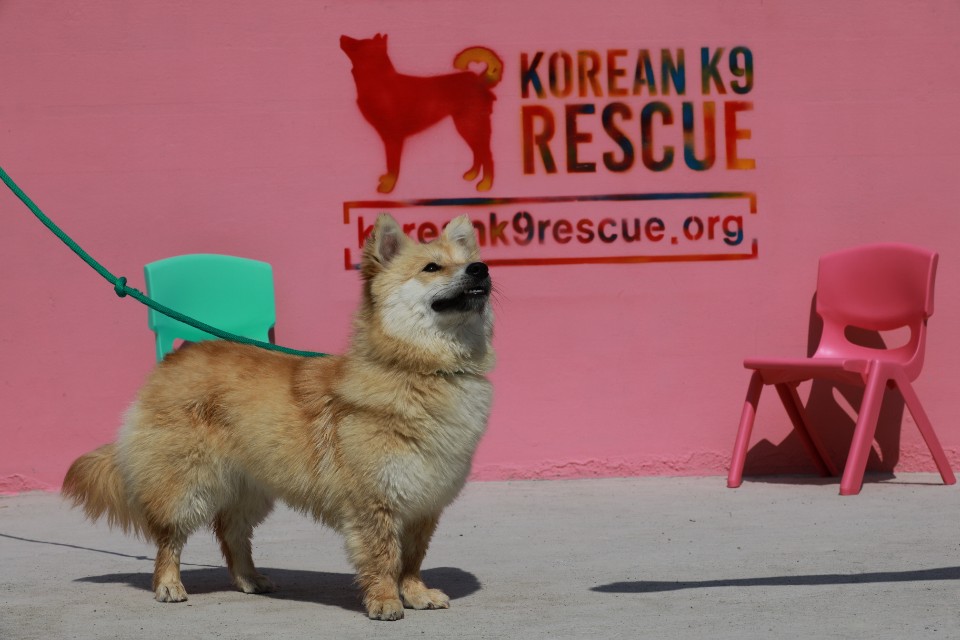
Your story makes me a little emotional every time I hear it. It is so special to be aligned with a group like yours. It is very meaningful to us.
It’s hard to witness, but I think if you see it for yourself someday, then you can understand the desperation of the situation. As outsiders, we can’t just go into Korea and extract all of these dogs. We have to work with the people that are helping these dogs, the citizens of Korea, who are doing the groundwork and making the efforts to negotiate these things. It’s a delicate balance, but we are all here for the same reason.
We really appreciate Just Food For Dogs beyond what any other company has done for us. You guys have done the most. That has made an impact on everything we are doing. It affects how we operate, how we move, how many dogs we adopt, the happiness of our adopters, and the happiness of our dogs.
The animal welfare laws in Korea are weak by international standards. What difficulties do the blurry regulations lead to in the animal welfare arena?
Animals can be considered livestock in Korea and also pets. There is a huge grey area. Dogs can be considered livestock when they are raised for consumption, right alongside goats, chickens, cows, and pigs. There is really no difference. The only difference is people’s perspective.
The ways the laws are written makes it really blurry. You can’t just go in and take a dog without there being consequences. If you don’t have the proper permission from local authorities or the owner, you will be arrested. On top of that, just the lack of animal welfare laws. The ones that exist are very weak. One of them is that you can’t slaughter a dog in front of another dog, but yet these dog butchers still do that. They want them to witness the suffering and the terrifying aspect of it because they believe the adrenaline that runs through their body, that fear, makes their meat more potent for medicinal purposes. There are ways that we go in and we can film this cruelty. It’s very hard to watch and hard to see, but we need that evidence and detective work in the beginning to make sure that the officials can finally step in and stop it.
That’s one way that we are able to help dogs in slaughterhouses and dog meat farms. The other way is just observing and reporting. Observing what is going on, keep documenting it and keep reporting it until we can convince somebody to do something about it. It’s not like here in the US where we have very clear animal cruelty laws, depending on what municipality you live in, and humane services that will step in and work with law enforcement to stop things. It doesn’t exist in Korea, especially in rural areas, which is what we are dealing with 90% of the time.
I cannot imagine the emotions you feel on a daily basis, Gina.
Just yesterday I was having a little bit of a meltdown, emotionally. We are dealing with a man that is deliberately starving a mom and puppies in the countryside. The mom is on a chain, and we are trying to convince this person to give up their dog and they won’t give them up. It’s a constant battle back and forth.
My team is brilliant at this stuff. I feel that we are very courageous and very methodical in how we approach these things. It’s really the team in Korea that is sacrificing. It’s their cultural knowledge and the way that they can solve these issues and get dogs off chains, close down slaughterhouses, and organize protests and rallies. That is really the backbone of what we do.
Describe the process of getting rescued dogs from South Korea to the United States. How difficult is that process?
It is definitely a difficult process. We are constantly trying to refine that process, and I feel that we make it as smooth as possible. When these dogs get rescued, they are not in great condition. They have been eating food waste, which is basically the leftover moldy, rotten food that humans discard and sometimes they are eating their dead friends in that food. We get bloodwork done right away and the numbers are all over the chart because they just don’t have the proper nutrition to sustain being healthy.
That road to recovery is step one. We have to get them on a nutritious diet, so they feel better on the inside. The next part is moving them into our rehabilitation facility and getting them fully vetted and also rebuilding their trust around humans. There are some behavioral things we may have to work on, and depending on the severity of trauma that dog has, it could take anywhere from 90 days to sometimes two years.
Once they are able to walk on a leash and wag their tail when they see a human, we can prepare them for their flight to NY or LA, which means they go through a quarantine process. The actual government of South Korea is very strict about animals leaving the country. They have a process. They must be fully vaccinated, they must have their full vaccines, must have their quarantine period signed off by a licensed vet, must be microchipped… everything. Then we have to go through the CDC, USDA and US customs. There are a lot of steps in between. Then we find flight volunteers. 90% of the time they are Korean citizens who are traveling from South Korea to either New York or Los Angeles. We will meet them at the airport with the dog and we will do all of the paperwork. They don’t even have to touch the dog. All they are doing is accompanying the dog on their journey here. Then a volunteer or staff member will meet them at the airport and pick the dog up. Then they go to their foster home.
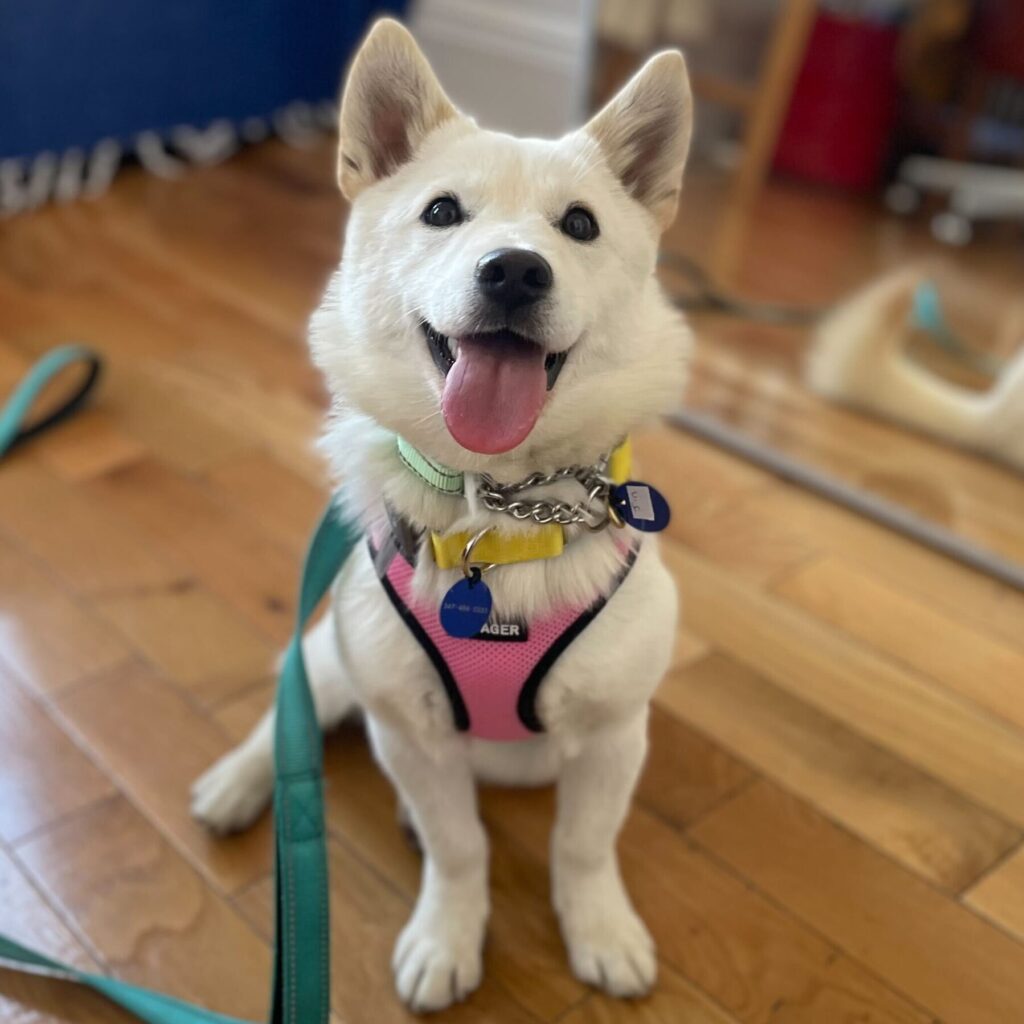
That is quite an ordeal. And that is for each individual dog. Those are a lot of hoops to jump through.
It’s a lot. The dogs are so resilient and brave and strong. It puts a lot of things into perspective as a human being. When I think about what the dogs go through, my problems are so small in comparison.
These dogs come from traumatic backgrounds, and then make the long journey to New York and Los Angeles. That must be very stressful for them. What type of adjustment period awaits the dogs when they arrive on US soil?
It’s a long adjustment period. Our center in South Korea is not designed to help them adjust to the stresses of a busy city like New York or LA. We do our best to simulate these kinds of environments, but we can never really prepare them for exactly what it will be like when they get here.
Each dog is different, but we try to set every dog up as much as we can for the experience here before they leave. We know that when the dog is ready, they will adjust really well in their foster homes. Even throughout the foster experience, there is a decompression period and a big part of that is crate training and good nutrition. We want to nourish them on the inside, so they feel better.
Even before they get to the US, a big part of their success is making sure that we are doing the right thing at our facility by helping them learn how to deal with the stress of an urban environment. The team in Korea does such a great job at that. Our trainers there are young, enthusiastic, and creative. They think of different ways to desensitize them to all of these things. They also just help them recover from the whole process. It’s amazing to see a dog come out of the crate with a wagging tail. That’s when we know they are ready. There are some dogs who take longer. Some puppy mill dogs take a long time because they didn’t have that socialization early in their life. Usually, meat farm and slaughterhouse survivors take a bit longer. They all come mostly prepared, and we just have to be the guide to get them to the point where they are feeling better about themselves.
You are very vocal about your holistic approach to canine wellness. How do you feel feeding JustFoodForDogs has changed things for the dogs in your care?
Korean Jindos are very picky eaters. We get a lot of Korean Village Dogs and Korean Jindo mixes and genetically, they will starve themselves until they absolutely need to eat. That is just part of their ancient breed DNA. I wanted to do a holistic approach, but some of the approaches I tried before were not palatable to them. They were not excited to eat. Since we switched to JustFoodForDogs over a year and a half ago, we really don’t have that issue anymore. All of the dogs find a recipe that works for them, and they immediately take to it. That alone speaks volumes.
They have been through a traumatic flight, they have been through their past trauma, and then they get out of their crate, and without hesitation they immediately start eating the Balanced Remedy recipe. It is such a different reaction than with what we were doing before. If they get bored of a recipe, we can change it and keep the momentum going. Many of the dogs come in malnourished, skinny and stressed. The nutrition alone helps them recover much quicker. They have more energy, and the nutrition is helping them to progress.
Our fosters also love it. Some of them are brand new to this and have never had a dog before. We hand them the package of JustFoodForDogs and explain to them how to serve it and they are so appreciative. You make it easy for them by supplying everything for them. That alone takes a lot of pressure off. They just got a new dog from a different country, and they worry about them eating. It can be a big challenge.
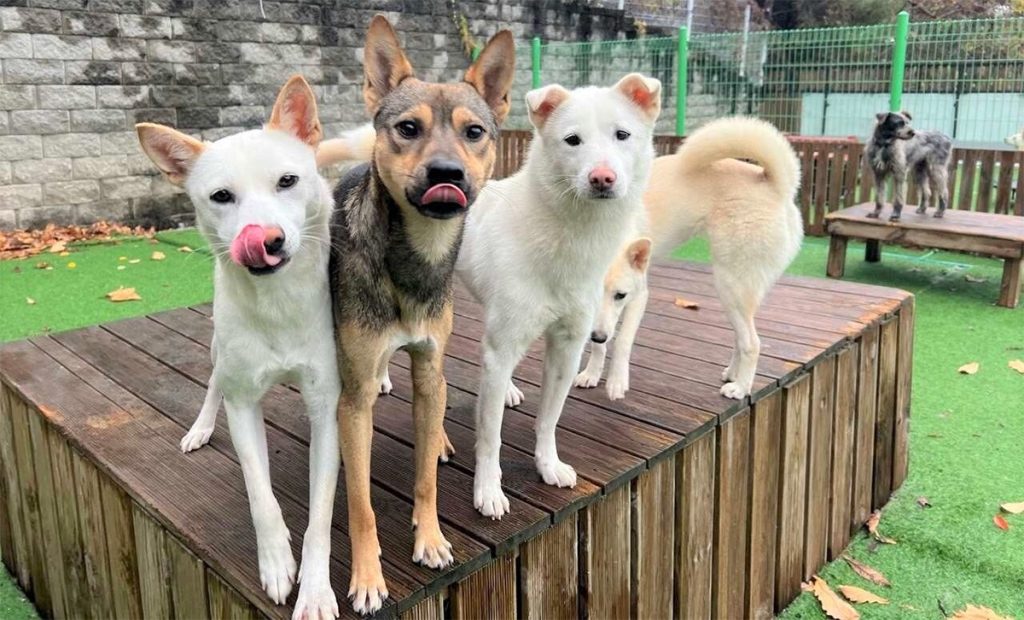
What is the adoption process like through Korean K9?
It is a little bit of a process, but it isn’t as difficult as people think it is. I believe that most of our adopters are new dog owners. They may have grown up with dogs and they may have had a family dog. But you grow up, you move to the big city, you have all this responsibility, and you want to help a dog. A Korean dog, on top of that, who has had trauma and abuse. You choose our organization because you believe in the mission. We are here to be your friend. We will hold your hand if you need it and give you the guidance that is necessary for these dogs to progress, and not just live, but thrive. That is always what our adoption process has been like. We are part of a community. We are part of a family. We don’t want you to feel like you don’t have the answers that you need. From the very beginning, we want to lay out everything that’s involved, from the cost of owning a dog to long-term health benefits of feeding a fresh food diet. We want to be here to answer every single question.
That process has made our adoption rate very successful and our return rate very low. When you apply to adopt a dog, you will get a very thorough approach, and all of your questions will be answered. You will get everything you need, from the day of your orientation to the day you pick up your dog. This can all happen very quickly after you are approved. It can happen in a matter of 48 hours. Even after you leave from picking up your dog, we are still here to guide you.
We also require training from one of our trainers. We have a total of 15 trainers, and they all understand the breed and the background of these dogs. Their approach is about what works for the dog and what works for the person adopting the dog. That kind of support along the way is very helpful for first time adopters, and even people who have had dogs before or who currently have a dog. They all appreciate the support. Many of our adopters comment on how different our dogs are. They are more of a challenge, and more patience is involved in waiting for them to come out of their shell. We always just stress that it’s a marathon, not a race. They will get there in time, and we will prepare you for that part of the journey with them.
What is one thing you wish the general public knew about adopting a dog, and more specifically, a dog from South Korea?
How wonderful they are. I want everybody to know that this breed is so unique. We want to express how important it is to support rescues. No matter where you choose your dog from, research the rescue. Read everything available online. Talk about it with your friends and family.
With the way things are going with the world today, post-pandemic, I just think the word “rescue” needs to be put back into conversations again. When you talk about dogs, the wonderful thing is being able to choose what kind of dog you want and where you get them from. Do your research and figure out what it is you want to be supporting. What is best for you. But when it comes to Korean Jindos, they are a wonderful, loving and kind breed. They are the most loyal breed you can find, in my opinion.
If you would like to learn more about how you can support Korean K9 Rescue, please visit www.koreank9rescue.org
You can follow them on social media @koreank9rescue
Natalie Lykins is the manager of the Adoption Project. She has an extensive history in animal care, having volunteered with many rescue organizations since her early teens, and previously worked at a vet clinic. She has found her true mission at JustFoodForDogs and, according to her, would not want to be doing anything else.
